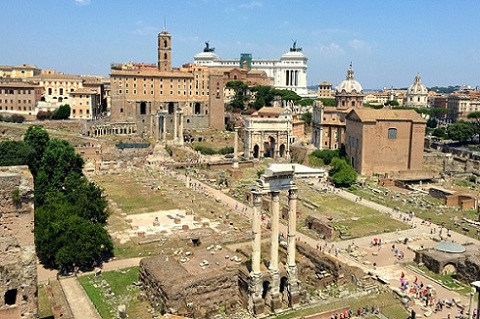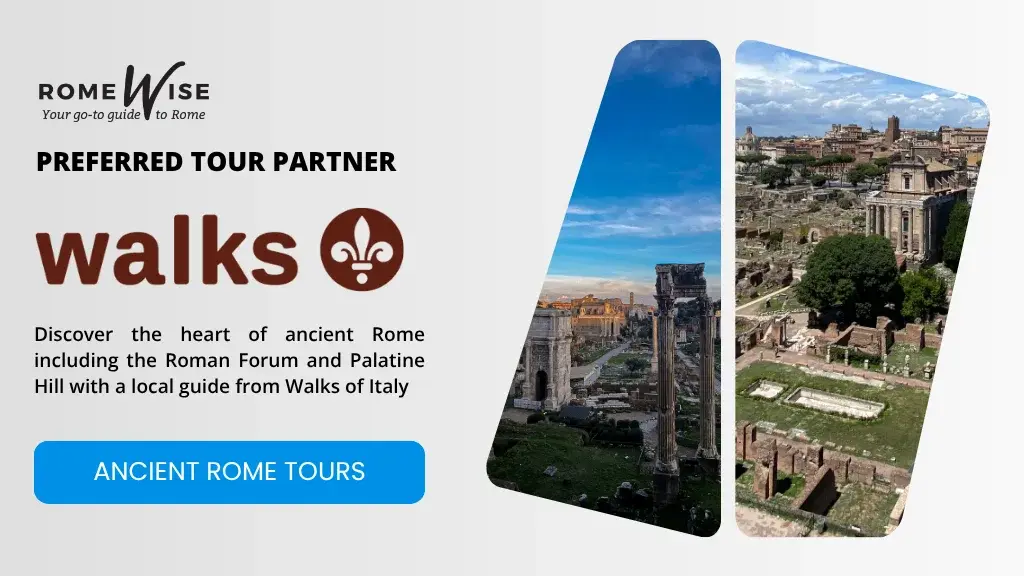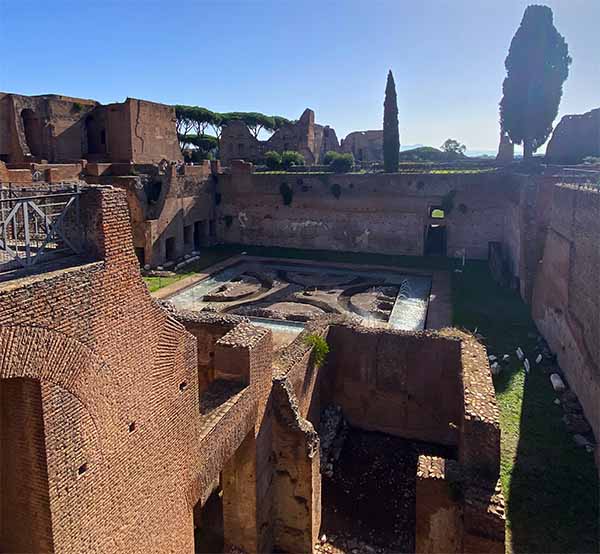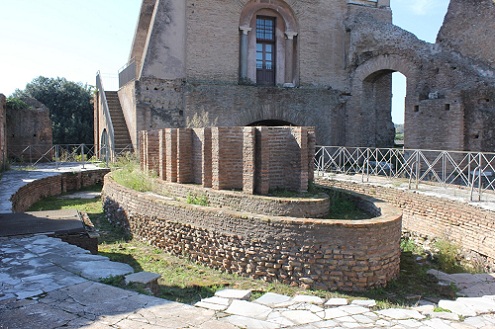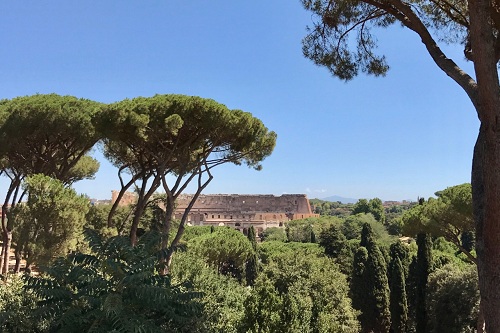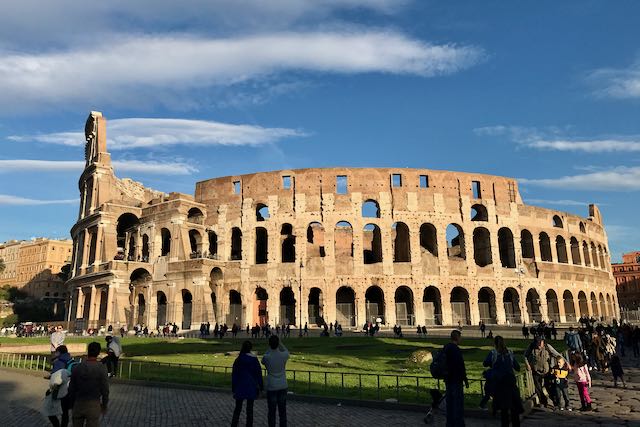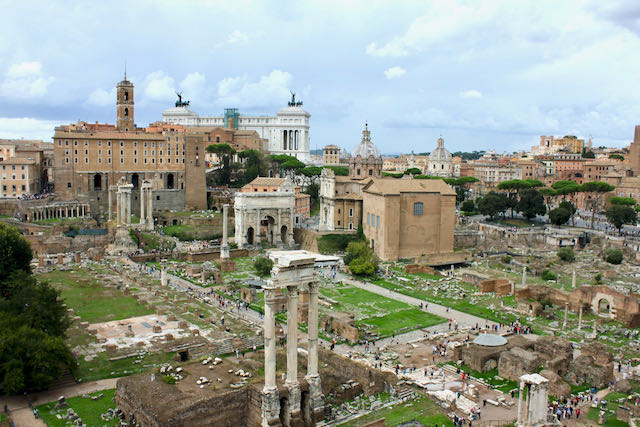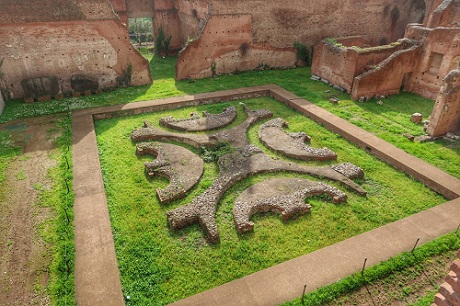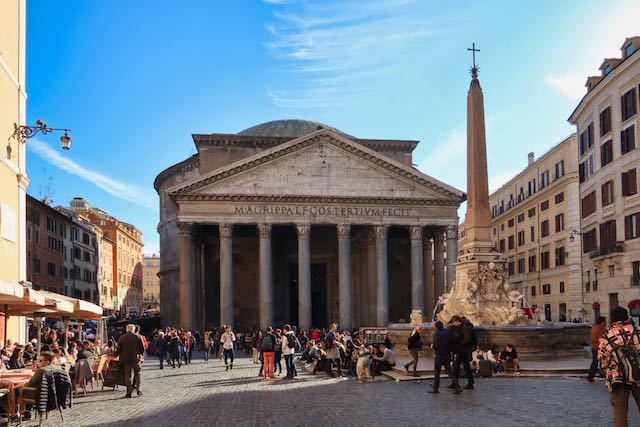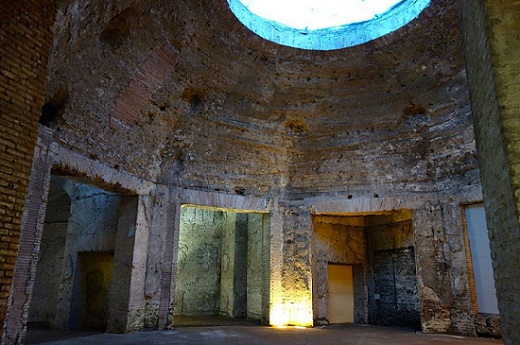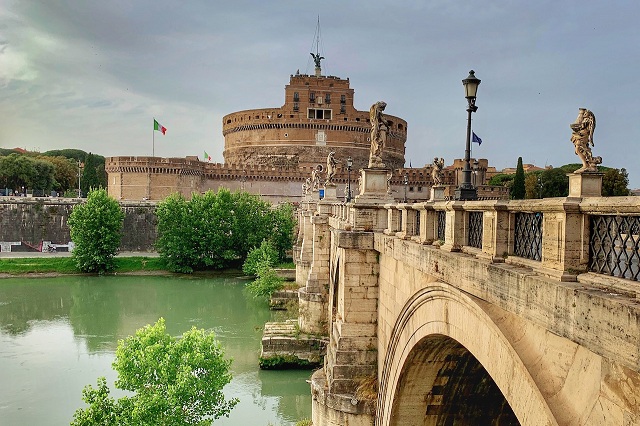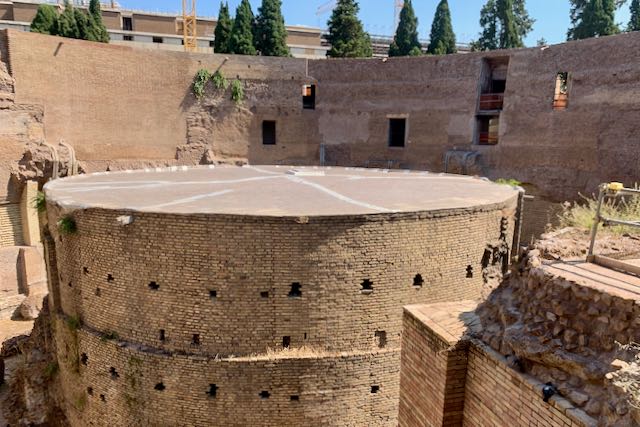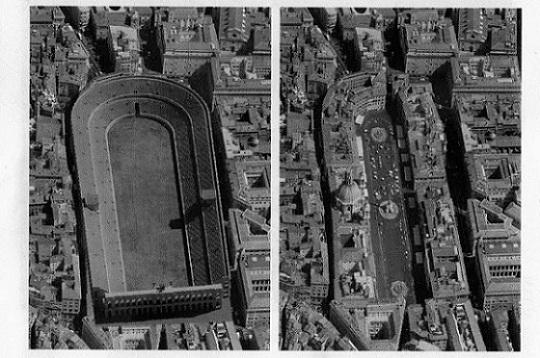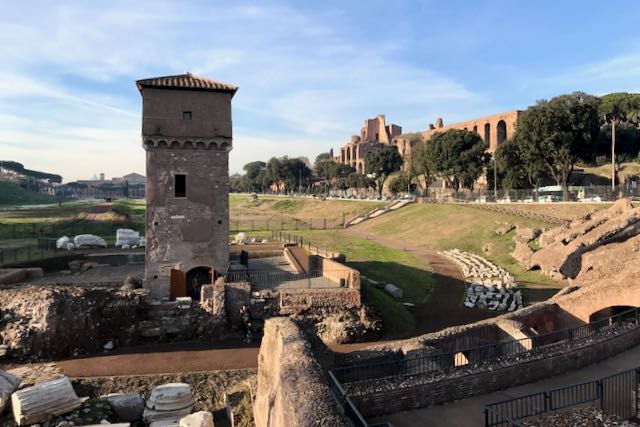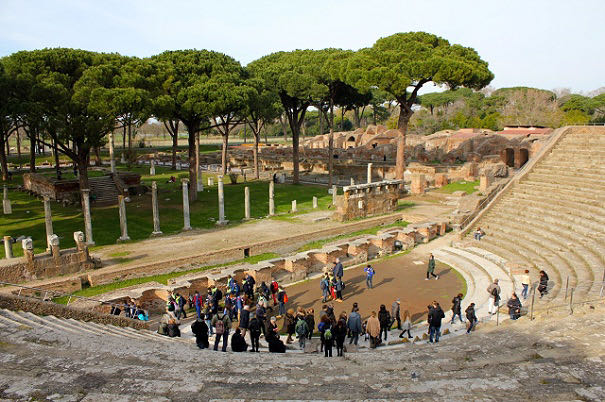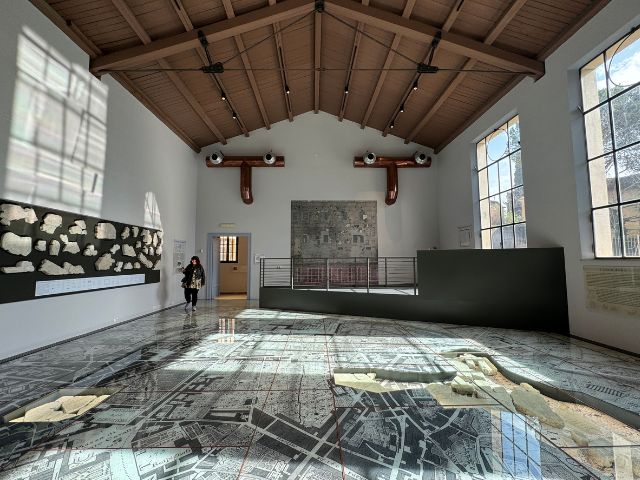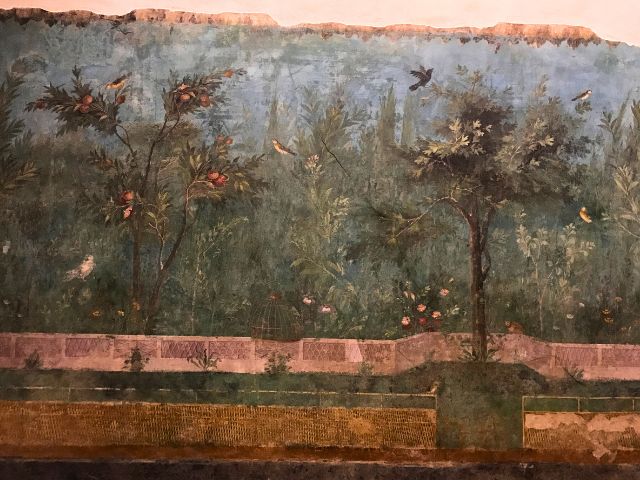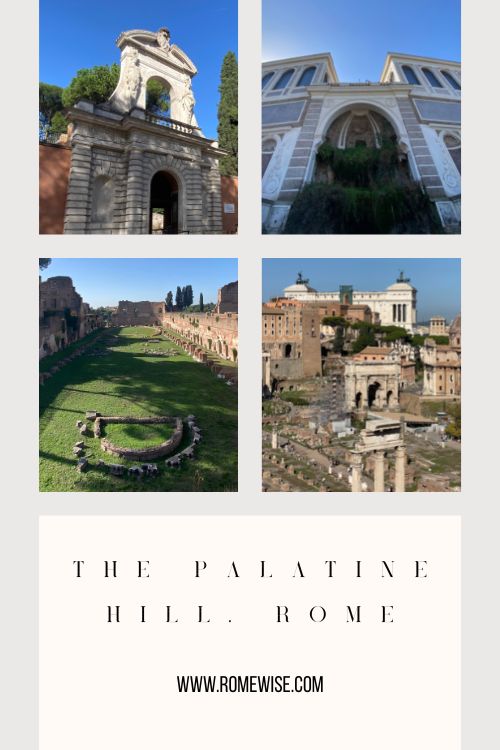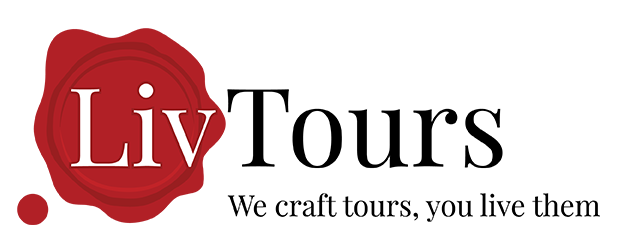- Sign up & get a FREE ebook Subscribe NOW!
- Romewise Home Page
- What to Do in Rome
- Romantic Things to Do in Rome
- Palatine Hill Rome
Palatine Hill Rome
May 15, 2025
Is the Palatine Hill worth visiting?
I am biased because I visit it often, but for me, it's one of the best sites you can visit from Ancient Rome or the Roman Empire.
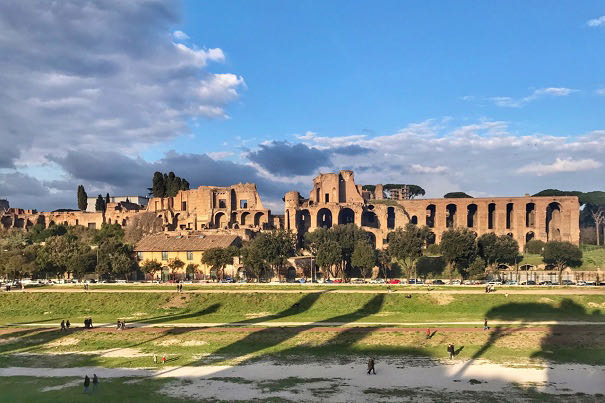 From the Aventine Hill, you can look across the Circus Maximus to see this gorgeous stretch of palatial structures on Rome's Palatine Hill. Can you believe it? These structures are just the BASE of what was once a massive imperial palace.
From the Aventine Hill, you can look across the Circus Maximus to see this gorgeous stretch of palatial structures on Rome's Palatine Hill. Can you believe it? These structures are just the BASE of what was once a massive imperial palace.All About the Palatine Hill Rome
I think a lot of people miss seeing the Palatine Hill because they may not know much about it, or probably more likely, they may run out of time and energy.
But if you love Ancient Rome, and/or have a fascination with the Roman Empire, the Palatine Hill is one of the things you should not miss on a visit to the Eternal City.
It sits at the heart of ancient Rome in the 'Parco Colosseo' which also comprises the Colosseum and Roman Forum.
This page will answer all of your questions, including:
- What is the Palatine Hill?
- Where is the Palatine Hill in Rome?
- What is there to see on the Palatine Hill Rome?
- How to visit the Palatine Hill
What is the Palatine Hill?
The Palatine Hill is the site of the Lupercal cave, which is where, according to legend, a she-wolf saved the young twins Romulus and Remus from certain death by suckling them from her teats.
Their great-uncle had feared they'd usurp him, and told a soldier to take them away.
He could not bring himself to kill them, so he left them by the river.
The boys then went on to fulfil their destiny of ruling over this hilltop settlement until they fought about who would be in charge.
Romulus killed his twin Remus, establishing himself as the first king of Rome and naming the city after himself.
The foundation of Rome is still celebrated today.
Due to its central role, the Palatine Hill became the living location in ancient times for the city's most powerful politicians, and later the emperors in sprawling imperial palaces.
The word "palace" comes from the word "Palatine."
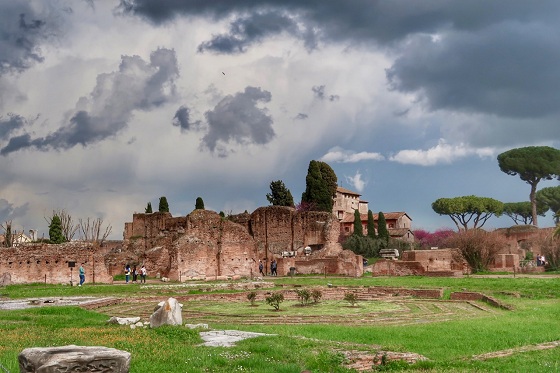 Even just walking around the Palatine Hill is a delight - you get to see ruins all around you, and imagine how the emperors once lived here.
Even just walking around the Palatine Hill is a delight - you get to see ruins all around you, and imagine how the emperors once lived here.Where is the Palatine Hill in Rome?
The Palatine Hill was the first of Rome's original seven hills to be settled permanently - this is because of its commanding presence in the centre of this part of the river Tiber floodplain and proximity to the river.
The Palatine was and still is at the very center of the ancient city of Rome - find it next to the Colosseum, across from Capitoline Hill, and above the Forum, just a short walk from Piazza Venezia.
It also looks over the Circus Maximus and can be seen from the Aventine Hill - it's hard to miss even if you're not planning to visit due to its prominent location.
Disclosure: If you make a purchase through a link on this page, I may receive a small commission - at no extra cost to you. Thank you for supporting my site!
What is there to see on the Palatine Hill Rome?
There is so much to see on the Palatine that even several visits would not be enough to take it all in!
These are some of the most important and, we think, interesting things to see when you visit:
Ancient Ruins
The hut where Romulus lived
Romulus is possibly a legendary character, even though it's true that people inhabited this area in the 8th century BCE.
Augustus, on the other hand was very real.
He was the first emperor of Rome, and his reign lasted from 27 BCE until his death in 14 CE.
Augustus ordered archeological excavations during his reign and upon discovering artefacts from the Iron Age he declared the Palatine Hill to be the birthplace of Romulus, and hence, of Rome itself.
Augustus built his home on the Palatine Hill right near the huts of Romulus.
(It's one of the things you can visit, and it's amazing! More on this below.)
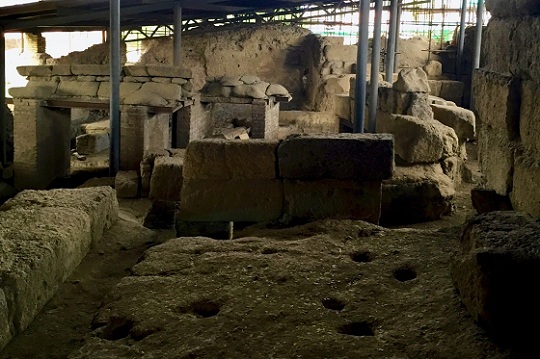 Up on the Palatine Hill Rome, one of the things you can see is this group of ancient structures, presumably the huts where Romulus, founder of Rome, lived in the 8th century BCE.
Up on the Palatine Hill Rome, one of the things you can see is this group of ancient structures, presumably the huts where Romulus, founder of Rome, lived in the 8th century BCE.Domitian's Palace
Emperor Domitian, of the Flavian Dynasty (the same family who built the Colosseum, and the stadium where Piazza Navona stands today), built one of the largest palatial complexes on the Palatine Hill.
Note that sometimes this structure is referred to as the Domus Augustana because elements within the imperial residence were likely first constructed during the reign of Augustus, the first emperor.
As such, don't be confused if you see signs referring to the 'Domus Augustana'.
Today Domitian's Palace is what we see the most when we walk around the very top of the hill.
Much of what is visible is actually the giant ruins of sub-structures that supported the palace - think about how huge the palace itself must have been!
Other emperors, including Tiberius, Nero (who built the Domus Aurea) and Septimius Severus also built palaces here, sometimes on top of, or adding to existing structures.
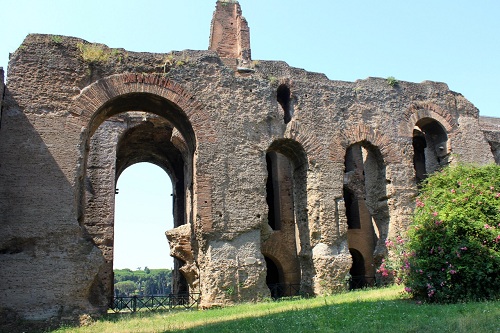 These ruins we see all over the Palatine Hill were structures used to support huge palaces of Domitian and other Roman emperors.
These ruins we see all over the Palatine Hill were structures used to support huge palaces of Domitian and other Roman emperors.Domitian's hippodrome & garden
It's likely that this huge space was a stadium for all kinds of games, viewable in private by the imperial family and their guests.
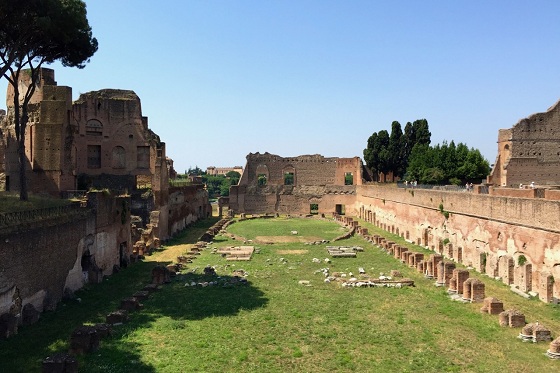 Often referred to as Domitian's hippodrome, this giant oval space high on the Palatine Hill may have been part of Domitian's garden, or a gymnasium or training ground.
Often referred to as Domitian's hippodrome, this giant oval space high on the Palatine Hill may have been part of Domitian's garden, or a gymnasium or training ground.Domitian's fountain (Nymphaeum)
Having been recently restored, you can now fully imagine Domitian's huge fountain in the center of the palace.
At points the fountain is on with peaceful music playing, adding an extra dimension to your Palatine Hill experience!
Go check out Maquettes-Historiques.net for more excellent renderings by André Caron of a lot of the structures that are talked about on this page.
The elliptical nymphaeum from the Domus Flavia
This is another structure that was the basis of a fountain.
What's so fantastic about this, besides its shape, is all the intact colored marble flooring around it.
Beautiful floor designs are still visible all over the Palatine Hill Rome.
I love these colorful marble floors near the elliptical fountain of the Domus Flavia.
The crazy floor from Jove's Cenatio (dining room)
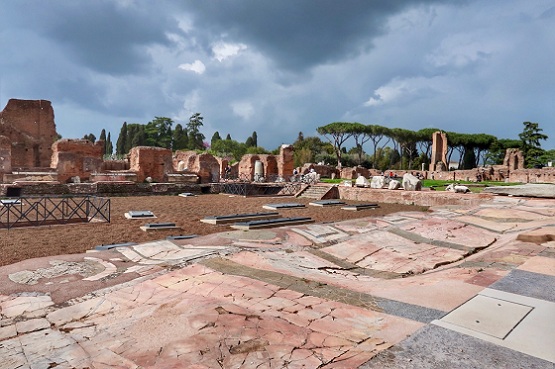 High on the Palatine Hill Rome, you can spot the cenatio (dining area) of the Domus Flavia with its beautiful, if not quite even, marble floors.
High on the Palatine Hill Rome, you can spot the cenatio (dining area) of the Domus Flavia with its beautiful, if not quite even, marble floors.Check out that beautiful pattern.
Next time you visit the Pantheon (designed just a few years later, in about 117 CE by Hadrian), or perhaps Trajan's Market (Trajan preceded Hadrian as emperor), compare those floor patterns to these.
I believe emperor Domitian may have set the standard for imperial floor design.
Speaking of floors, how about this section pictured above with this crazy undulating marble, which was probably a dining area.
This section and the oval fountain, are part of what is known as Coenatio Iovis (Jove's dining area).
Or, it may have been just an area where the emperor could receive guests.
One more fountain - designed like a labyrinth
This octagonal fountain was yet another part of the Domus Flavia (Domitian's Palace) on the Palatine Hill Rome.
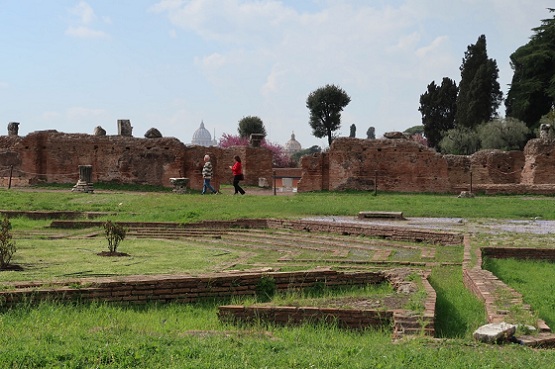 Next to the Triclinium (above), and the Palatine Museum, you can also make out the octagonal shape of yet another nympheum (fountain) that was part of Domitian's Palace.
Next to the Triclinium (above), and the Palatine Museum, you can also make out the octagonal shape of yet another nympheum (fountain) that was part of Domitian's Palace.While there is not much left of it, you still get the sense that this was a pretty sumptuous structure.
The Palatine Hill during Rome's Renaissance
THE FARNESE ROSE GARDENS
After the fall of the Roman Empire and up until the end of the middle ages, Rome as a city shrank to a fraction of what it was during ancient times.
The area around the Colosseum, Palatine and Forum was all but abandoned.
However, in 1537 Cardinal Farnese (nephew of the Farnese Pope, Paul III) began a program of building and excavation on the Palatine.
One of the remaining projects from this era still visitable are the lovely rose gardens.
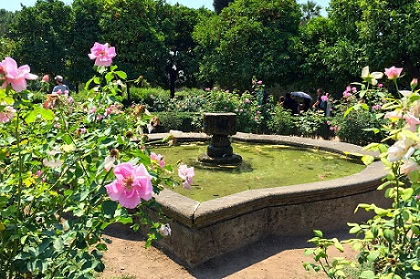 This pretty garden high on the Palatine Hill is lovely when the roses are blooming. There is also a drinking fountain nearby, a panoramic overlook, and the larger Farnese gardens (below).
This pretty garden high on the Palatine Hill is lovely when the roses are blooming. There is also a drinking fountain nearby, a panoramic overlook, and the larger Farnese gardens (below).THE HORTI FARNESIANI (FARNESE BOTANICAL GARDENS)
In the 16th century, Cardinal Farnese also built what is considered Europe's first botanical garden right here on the slopes of the Palatine Hill, on top of the foundations of the Domus Tiberiana.
They included a huge variety of plants, fountains, aviaries, and grottoes.
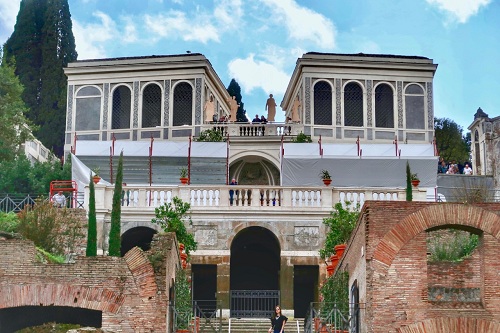 The Horti Farnesiani, or Farnese Botanical Gardens, have been restored to give us a sense of what they were like when they were first built in the Renaissance by Cardinal Alessandro Farnese.
The Horti Farnesiani, or Farnese Botanical Gardens, have been restored to give us a sense of what they were like when they were first built in the Renaissance by Cardinal Alessandro Farnese.These gardens were recently brought back to life and you can now visit them, or at least get a sense of what they were like back in their heyday.
Check out my YouTube video all about visiting the Farnese gardens:
Some pretty amazing viewS!
You can see the Colosseum from many different points on the Palatine Hill Rome.
From up here, you get a very different view of it than from ground level.
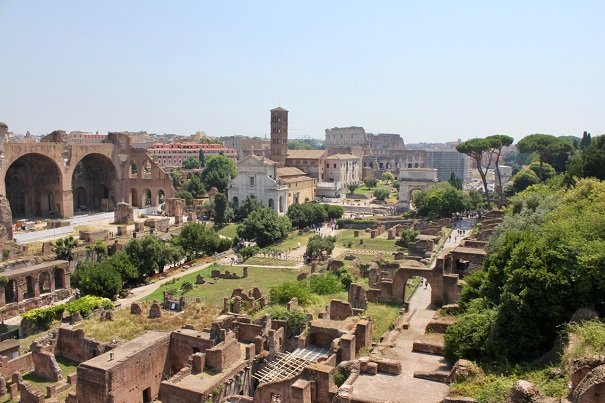 You can also see the Colosseum from the main vista point, where you have views over all of the Roman Forum too.
You can also see the Colosseum from the main vista point, where you have views over all of the Roman Forum too.You also have lots of views of Rome's tallest dome, St Peter's Basilica.
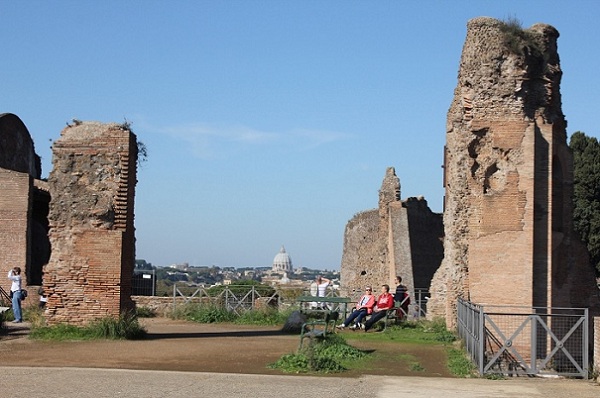 From the Palatine Hill, it's easy to see the majestic dome of Saint Peter's basilica, from all the way across the river.
From the Palatine Hill, it's easy to see the majestic dome of Saint Peter's basilica, from all the way across the river.Explore other sites from Ancient Rome
Visit the Palatine Hill Rome
Here are our top tips:
- Bring a water bottle and snacks - beyond a few vending machines, there are no places to buy food. There are water fountains dotted around the hill.
- Wear super comfortable shoes and clothing
- Bring an umbrella in wetter months, and a hat and sunblock in warm months
- Pace yourself and don't worry about seeing it all
The best way to visit on your first time is with a guided tour.
The area is huge and there is so much to see.
A good tour, and good tour guide, can help you focus on some of the most interesting parts, while giving you the info and background stories to tie it all together.
If you go on your own, you might consider getting the audio guide (you can decide on-site).
If you have been before, or are feeling adventurous and want to go on your own, I recommend starting your ancient Rome visit on the Palatine.
You will be high up, and can then make your way down into the Forum.
Then you can visit the Colosseum once you exit the Forum.
For an extra special experience, book an in-depth, small group tour led by a local expert guide of the Colosseum, Roman Forum and Palatine Hill so you can fully immerse yourself in ancient Rome!
How much does it cost to enter the Palatine Hill?
PALATINE HILL tickets - standard entry
The ticket you buy to enter the Palatine Hill is the same ticket to the Colosseum, and the same ticket to the Roman Forum.
In other words, you just need to buy one combo ticket.
A standard ticket costs 16€.
There is a 2€ fee to pre-book this one ticket in advance, which is now the only way to book, so the ticket comes to 18€ for adults.
Tickets can be booked here from the official site.
Colosseum Ticketing Update April 2024
A brand new ticket system has been launched for tickets to the Colosseum, Roman Forum, Palatine Hill and Domus Aurea - check it out here.
A few things to note with this new system:
1. It only applies for tickets from May 1 2024 onwards. If you want to purchase tickets for April 2024, you will need to use the old CoopCulture website.
2. Tickets are currently being released a month out, day by day. On April 8 tickets for May 8 became available, on April 9 tickets for May 9 get released and so on.
3. The new website has a system which puts visitors in a digital queue before letting them on to the site itself, to stop the site crashing due to demand, so don't worry if you don't get onto the site immediately.
4. Not all ticket/tour options are available to purchase yet so keep checking back if what you want isn't available.
USING THE ROMA PASS TO ENTER THE PALATINE HILL ROME
The Palatine Hill/Roman Forum/Colosseum are all included in the Roma Pass.
Here's how it works:
With the standard 3-day Roma Pass, you get to visit 2 sites for free.
Let's say that one of the sites you want to visit for free (and of course skip the line), is the Colosseum.
When you use the Roma Pass, you still receive an actual ticket to the Colosseum.
And on that ticket, it says, good for entry to the Colosseum/Roman Forum/Palatine Hill.
If you use the Roma Pass to visit the Colosseum for free, you get the two other sites, the Forum and the Palatine Hill, for free.
And this all counts as ONE site as far as the Roma Pass is concerned.
Remember, with the standard ticket to the Parco Colosseo, you must visit the Colosseum and the Roman Forum/Palatine Hill on the same day.
ENTRY TO THE PALATINE HILL ROME WITH OTHER ROME PASSES
Things You Can Only See with the S.U.P.E.R. ticket
There is one other type of Rome combo pass you can purchase, and it includes free skip-the-line entry to the Palatine Hill/Forum/Colosseum:
- The Best of Rome All Access pass, offered by Tiqets, also includes skip the line entry to the Vatican Museums + Sistine Chapel. You'll also get guided tour of St. Peter's Basilica. All this is done completely with your mobile device.
DISCOUNTS AND FREE ENTRY TO THE PALATINE HILL ROME
A reduced ticket is 4€.
This price is for Europeans between 18-25, journalists, and European teachers.
Children under 18 do not have to pay, but do need to have a ticket. When booking for a group, be sure to include as many free tickets as there are children.
All children must be accompanied by an adult.
Some other people can also visit for free.
I recommend visiting the official site here to see if you are eligible and for more details around the rules for children and reduced ticket holders.
What is the Full Experience ticket (formerly know as the SUPER ticket) and should you get it?
Just above, I listed the standard, discounted, free entrance tickets and passes for the Palatine Hill.
There is another type of ticket available called the Full Experience ticket, which for an extra cost gives you additional access to explore Roman history in the Eternal City.
The Full Experience ticket allow you to split your visit over 48 hours, so you can visit the Colosseum one day and then the Forum and Palatine Hill area the next.
The days must be concurrent!
The Full Experience for the Colosseum gives you access to the Arena or the Underground (advance booking is still essential), and in the Palatine Hill/Roman Forum area you can visit:
- The House of Augustus, home of Rome's first emperor Augustus featuring incredible frescoes.
- The House of Livia (Casa di Livia), the home of emperor Augustus' wife Livia, located close to the House of Augustus.
- The Domus Transitoria - Nero built this house before relocating to his famous 'Golden House', the Domus Aurea.
- The Palatine Museum - this small museum houses a well curated collection of incredible ancient Roman pieces, most of which were found on the Palatine.
- Santa Maria Antiqua & Domitian's Ramp - this example of an early Christian church features breathtaking frescoes, perfectly preserved after being buried by an earthquake for over 1000 years.
- Mattei Loggia & Aula Isiaca - inside this space you'll find an Augustan-era room dedicated to the goddess Isis with stunning frescoes, and a decorated covered area created by the Mattei family in the Renaissance period.
Note that the schedule of when these sites are open varies - be sure to check the official site in advance of your visit.
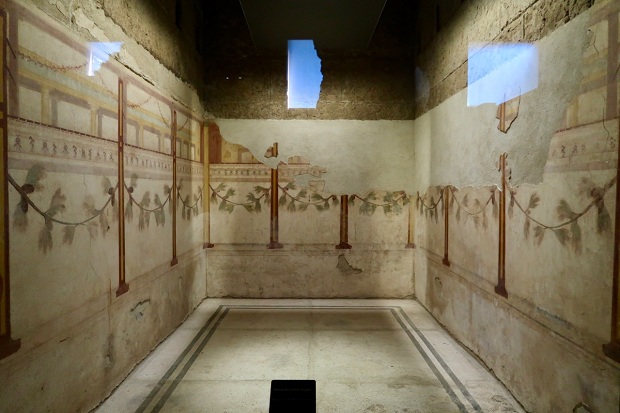 This room, "Room of the Pine Festoons", is yet another example of a fantastically-preserved second-style painting in the House of Augustus on the Palatine Hill Rome.
This room, "Room of the Pine Festoons", is yet another example of a fantastically-preserved second-style painting in the House of Augustus on the Palatine Hill Rome.You cannot use the Roma Pass or any other pass to get inside these sites.
Full Experience tickets must be booked online - you cannot purchase these, or any other tickets on-site at the entrances to the Parco Colosseo.
The booths are manned only for giving out information to visitors.
At one time these sites were known as SUPER sites, so you may well find references to this online and in the park.
Find out more about these special sites in this video:
Where to buy skip-the-line tickets to the Palatine Hill Rome
You can book tickets to the Colosseum/Roman Forum/Palatine Hill online, on the Parco Colosseo website.
You can also buy them at many online ticket vendors that offer mobile tickets.
How long does it take to visit the Palatine Hill Rome?
The Palatine is an enormous stretch of land (its circumference is 5,700 feet, or 1,740 meters).
But besides the size of it, there is just so much to see, if you want to.
I think for most people visiting Rome, you will typically spend anywhere from half an hour to a half a day visiting the Palatine Hill Rome.
But if you use a Full Experience ticket, you will need more time, even on a single day (You need almost two full hours if you want to visit the House of Livia and the House Augustus alone).
When should you visit the Palatine Hill Rome?
The Palatine Hill (and Roman Forum and Colosseum) all open at 9 AM every day.
Closing time is "one hour before sunset", and so changes a lot throughout the year.
Last entry is one hour before closing time.
For the complete schedule, visit Parco Colosseo.
When the weather is warm I would always suggest visiting it during the hottest part of your visit to Ancient Rome.
This is the only one of the three parts of the Parco Colosseo that has plenty of shade and places to sit down.
The Colosseum and Roman Forum are both devoid of shade and seating.
So if you have a morning visit, go to the Colosseum first, then the Forum and then the Palatine closest to noon.
If you have an afternoon visit, start at the Palatine, work your way down to the Forum, and finally visit the Colosseum.
How to get to and enter the Palatine Hill
You can enter the Palatine Hill directly on via di San Gregorio 30.
You can also access the Palatine Hill from the Roman Forum, simply by walking up the hill, either through the middle (and the Farnese Gardens), or on the side of the Forum where the Arch of Titus is.
You can leave the Palatine Hill at the entrance on via di San Gregorio 30, or you can go into the Roman Forum and leave it from there, at the various exit points, in many different spots, depending on where you want to go.
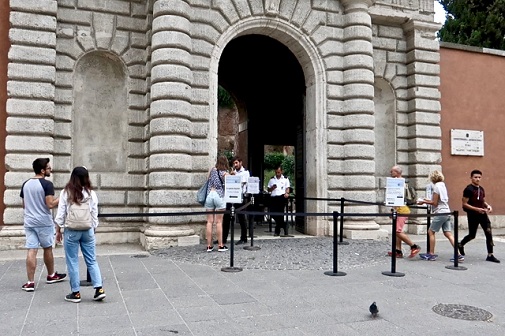 This is the entrance to the Palatine Hill. However, it is no longer a ticket office. You must book tickets in advance, online or by phone.
This is the entrance to the Palatine Hill. However, it is no longer a ticket office. You must book tickets in advance, online or by phone.GETTING TO THE PALATINE HILL BY METRO
If you plan to come to the Palatine Hill by Metro (subway), you'll be coming by Blue Line B.
The Blue Line B Metro stop at the Colosseum.
You can get off here or at the next stop, Circo Massimo (Circus Maximus), to start your visit.
Get off at Circo Massimo (closest to the Palatine Hill), or at the Colosseo stop (closest to the Colosseum but also only about a 10 minute walk from the Palatine Hill entrance).
GETTING TO THE PALATINE HILL BY BUS
If you decide to reach the Palatine Hill by bus, remember that on Sundays, the via dei Fori Imperiali is completely pedestrianized, so you will have to get a bus that stops nearby.
There are dozens of buses that take you to or near the Palatine Hill/Colosseum.
If you have a smartphone or device with data, you can easily use Google maps to see what transportation will get you there.
You will want to either go to the Colosseum (Piazza del Colosseo 1) or to the Palatine Hill entrance (via di san Gregorio 1).
GETTING TO THE PALATINE HILL BY HOP-ON/HOP-OFF OPEN BUS
There are many different companies offering hop-on/hop-off open bus tours of Rome.
They are all similar and every single one of them includes a stop at the Colosseum.
In fact, the "Colosseum" stop is actually right at the entrance of the Palatine Hill!
WALKING TO THE PALATINE HILL
If you are enjoying a day of walking to, from and around the ancient Romans sites, you'll want to walk up the via dei Fori Imperiali.
Another option is to come from the Circus Maximus, especially if you've included some sight-seeing on the Aventine Hill, and maybe to the orange tree garden or the rose garden.
Ready to plan your trip?
Book your train
Planning to travel between cities in Italy and other parts of Europe?
Use Trainline to see all the different options available across the different rail companies.
Find your hotel
Find your perfect place to stay in Rome.
Use Booking.com to choose between hotels, guesthouses, and self-catering apartments in neighborhoods throughout the Eternal City.
Buy your TurboPass
Purchase the convenient Turbopass and visit all of Rome's top attractions including the Colosseum, Pantheon, and Vatican.
With one handy pass, it's all included.
Can you eat in or near the Palatine?
Within the Palatine Hill area you won't find a cafe, bar or restaurant. However, there is a small cafe in the Roman Forum, located the exit on the Via dei Fori Imperali.
Note though this could be quite a walk depending on where you are in the park.
You will find a handful of vending machines on the Palatine Hill (and within the Roman Forum), but I would recommend either bringing your own snacks, or visiting in the early morning or afternoon and having lunch after/before your visit.
How accessible is the Palatine Hill?
It's not easy to navigate the winding, uneven paths and roads that cover the Palatine.
Parts of the pathways are also very steep, so you should always take care when exploring.
With a wheelchair, it's very difficult.
This is true of strollers as well.
You are better off coming without a stroller if you can help it.
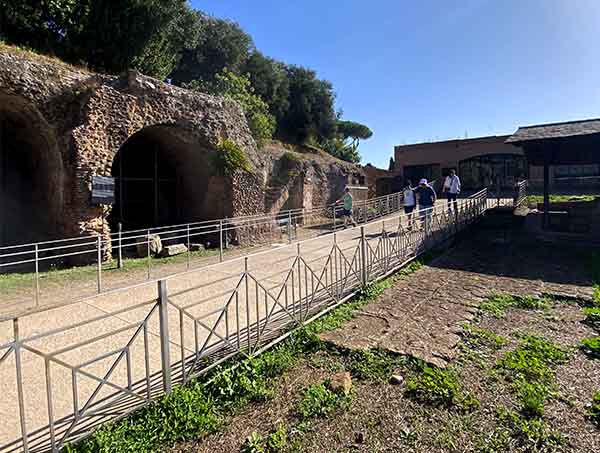 Navigating the Palatine Hill Rome in a wheelchair is not easy, due to so many uneven places on the ground and limited paved walkways but you will find some ramps to aid access.
Navigating the Palatine Hill Rome in a wheelchair is not easy, due to so many uneven places on the ground and limited paved walkways but you will find some ramps to aid access.I have found one company that offers a unique kind of wheeled-chair that gives someone who cannot walk a way to get around these kinds of archeological sites.
The apparatus is called a "wheely-trekky" and it does look like a good solution for getting around the Palatine Hill in a wheelchair.
(nb - I am not affiliated with this company in any way. Please contact them directly for all enquiries.)
Where are the bathrooms?
You can find restrooms (that are pretty clean and modern) on the Palatine Hill Rome at the following locations:
- Right when you enter the Palatine Hill (immediately to your left)
- Next to the Palatine Museum
- Next to the Farnese Rose Garden (the entrances are sort of hidden, but they are right behind the drinking water fountain there.)
- Near the overlook of Domitian's stadium
- On the slope between the Palatine and the Forum, near the baths of Elagabalus
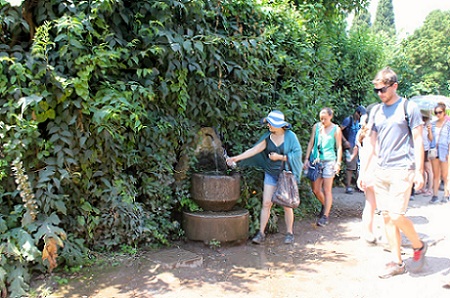 There is almost always a line and crowd around this drinking fountain on the Palatine Hill Rome, right next to the Farnese rose gardens. You will find bathrooms hidden behind that ivy.
There is almost always a line and crowd around this drinking fountain on the Palatine Hill Rome, right next to the Farnese rose gardens. You will find bathrooms hidden behind that ivy.Map of Palatine Hill, Roman Forum, and Colosseum
I've also included entry and exit points, and specific places of interest in the Roman Forum and Palatine Hill.
Romewise's Top Travel Resources
Ready to book your trip to Rome? Take a look at these helpful links to companies we use and trust:
- Keep your travel spending simple with the Wise card, which removes all the worry about exchange rates and high transaction fees all over the world
- Search for and book your perfect accommodation
- Our complete guide to what to pack for Rome
- The number one travel accessory, a multi-point travel adapter and voltage converter
- Browse a huge range of tours in Rome and beyond
- Experience unique tours and special access to Rome's most popular sights
- Protect yourself with comprehensive travel insurance
Within this post there are some affiliate links for products and services. For more details about our affiliate policy click here.
Get your 100% free Rome trip planner now!
Simply sign-up today for our free newsletter and get the Romewise Quick Start guide to Rome:
We are committed to respecting your data. Click for our Privacy Policy.
Comments? Questions? Suggestions?
Please come over to the private Romewise Facebook group and join in the conversation.
You will often find me there, happy to answer your questions / comments!
You will also meet other Rome lovers and experts, too.
What are you waiting for?
- Romewise Home Page
- What to Do in Rome
- Romantic Things to Do in Rome
- Palatine Hill Rome


